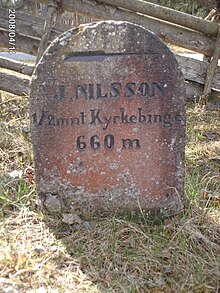Path module

Road building blocks or road maintenance stones mark roads and paths that the maintenance and maintenance of which was not the responsibility of the community but of private individuals, mostly farmers . How long the route to be maintained depended on the size of their property. However, there were alleviations, that is, shortening of the routes to be preserved if the preservation was particularly expensive.
In Sweden , such road markings were set up from 1628, when the newly created Lantmäteriverket was given the task of measuring roads and paths in plots. The markings were of various shapes and were made of both wood and stone. On the road blocks there were usually the consecutive number and the name or initials of the person responsible for the parcel and sometimes information about the length and direction of the route to be maintained. The stone markings, which, like the old milestones, are now a listed building, have been preserved best .
The Mittmille stone on the Swedish Baltic Sea island of Öland is an old building block . In Munkedal , along the west bank of the river Munkedalsälven, various mile and path building blocks from the area were collected and set up for inspection.
Road modules were also available in Germany. In Hamburg , two road modules on the Curslacker Heerweg are under monument protection.
Web links
Individual evidence
- ↑ The road component, old traffic routes and their relics - embedded in the brick walls of the Marktkirche on the Neustadt am Rübenberge side from November 2006
- ↑ List of monuments of the Free and Hanseatic City of Hamburg, as of April 13, 2010 (PDF; 915 kB) ( Memento from June 27, 2011 in the Internet Archive ) (PDF; 915 kB) Curslacker Heerweg 11 and Curslacker Heerweg north No. 5, Rieckweg; under monument protection since 2005
